
Enhancing Tactical Communications at the Edge with Sealevel Products: A Strategic Advantage for Military Operations
Space Lasers Aiming Towards Next Leap in Global Communications
The Journal of Military Electronics & Computing
March 2024, Volume 26 - Number 3 • cotsjournalonline.com
JOURNAL


COTS (kots), n. 1. Commercial off-the-shelf. Terminology popularized in 1994 within U.S. DoD by SECDEF Wm. Perry’s “Perry Memo” that changed military industry purchasing and design guidelines, making Mil-Specs acceptable only by waiver. COTS is generally defined for technology, goods and services as: a) using commercial business practices and specifications, b) not developed under government funding, c) offered for sale to the general market, d) still must meet the program ORD. 2. Commercial business practices include the accepted practice of customer-paid minor modification to standard COTS products to meet the customer’s unique requirements.
—Ant. When applied to the procurement of electronics for he U.S. Military, COTS is a procurement philosophy and does not imply commercial, office environment or any other durability grade. E.g., rad-hard components designed and offered for sale to the general market are COTS if they were developed by the company and not under government funding.


Editor’s Choice for March
6 The Inside Track DEPARTMENTS COT’S PICKS 28
The Journal of Military Electronics & Computing JOURNAL
Enhancing Tactical Communications at the Edge with Sealevel Products: A Strategic Advantage for Military Operations By John Reardon, Editor - COTS Journal Cover Image Phalanx Fire An MK 15 Phalanx close-in weapon system fires from the aircraft carrier USS Carl Vinson during a live-fire exercise in the South China Sea, Dec. 26, 2023. 3 COTS Journal | March 2024
Space Lasers Aiming Towards Next Leap in Global Communications
Rick Williams,
Precision Product
SPECIAL FEATURE 14
SYSTEM DEVELOPMENT 20
By
Kaman
EDITORIAL
EDITORIAL SUBMISSION AND RELEASES
johnr@rtc-media.com
PUBLISHER/CEO
John Reardon Johnr@rtc-media.com
CONTRIBUTING EDITORS
Tom Williams
Glenn ImObersteg
Robert Hoffman
ART AND PRODUCTION
CREATIVE DIRECTOR
David Ramos drdesignservices@ymail.com
DIGITAL MARKETING MANAGER
Scott Blair Scott@blair-media.com
AD TRAFFIC
Vaughn Orchard Vaughno@rtc-media.com
FINANCE AND ACCOUNTING
Paige Reardon paiger@rtc-media.com
ADMINISTRATION/CIRCULATION
Dawn Dunaway dawnr@rtc-media.com
ACCOUNT MANAGER
SALES MANAGER
Vaughn Orchard Vaughno@rtc-media.com

Journal of Military Electronics
Computing
COTS Journal | March 2024 4
The
&
JOURNAL
COTS Journal CORPORATE OFFICE RTC Media 3180 Sitio Sendero, Carlsbad, CA. 92009 Phone: (949) 226-2023 Fax: (949) 226-2050 www.rtc-media.com PUBLISHED BY RTC MEDIA Copyright 2024, RTC Media. Printed in the United States. All rights reserved. All related graphics are trademarks of The RTC Group. All other brand and product names are the property of their holders. CUSTOM AND CONTRACT SERVICES John Reardon Johnr@rtc-media.com

The INSIDE TRACK NATO accelerator and two test centers to be established in Finland
NATO’s DIANA (Defence Innovation Accelerator for the North Atlantic) program is expanding its network with new sites. Finland is now part of the network since the Board of the DIANA initiative approved a proposal to establish an accelerator and two test centers in Finland. The program’s mission is to help companies develop technology, innovation, and business for the civil and defense sectors.
The preparatory work, which started in spring 2023 and was led by the Ministry of Defence and VTT Technical Research Centre of Finland and required input from several operators, has reached its desired conclu sion. VTT is setting up a DIANA accelerator in Otaniemi, Espoo, in collaboration with Aalto University and the University of Hel sinki. The test centers will be established at the University of Oulu and VTT’s Otaniemi site.
The operations to be established in Finland will build on decades of solid technological expertise and market success. The accelerator and test centers’ technology themes are related to next-generation communication systems, 6G technology, cybersecurity, quantum, and space technologies.
“VTT is honored to be part of the DIANA network and its accelerator and test center activities. Finland’s world-class expertise helps pioneering companies to develop the deep technologies that will safeguard NATO and its billion inhabitants,” says Sauli Eloranta, Vice President of Defense at VTT.
provide a special training program that will help companies develop deep technologies and innovations for commercial and defense purposes. It will also provide companies with extensive and varied training on developing business opportunities in the defense sector.
The accelerator’s services will target start-ups and SMEs with limited experience in the defense and security sector.
“The long-awaited decision is signifi-
est-growing industry internationally – I hope Finnish companies will participate as widely as possible,” says Eloranta.
DIANA selects accelerator companies through its application process, which is called the DIANA challenge program. The first round of applications for the Finnish DIANA accelerator will be launched in 2024, and it will be open to start-ups developing dual-use solutions in NATO countries.

Test centers provide tools for further technological development.
The technology test centers will be established at VTT’s Otaniemi site and the University of Oulu. VTT’s Otaniemi Test Centre will focus on secure connectivity, space, and quantum technologies. The University of Oulu test center will allow companies to test 6G network technologies.
DIANA accelerator to train companies to operate in the defense sector
VTT is setting up a DIANA accelerator in Otaniemi, Espoo, in collaboration with Aalto University and the University of Helsinki, which will focus on future communication systems and quantum technologies. This will
cant for Finland as it is the first time Finnish operators can harness their cutting-edge expertise for NATO’s DIANA innovation activities on such a large scale. Our country has many technologically advanced and innovative start-ups and SMEs, which have found it difficult to invest in exports in the defense sector. DIANA will support this activity free of charge by using the accelerators to train companies in NATO technical and procurement requirements and developing company-specific business training programs. Such a mechanism provides a high-speed lane for companies to enter a difficult but fast-
DIANA test centers are places where companies can strengthen their technological expertise and competitiveness. The research infrastructure and experts the test centers provide will allow companies to evaluate their own concepts and technologies and get support to develop them. In practice, the test centers will consist of a comprehensive set of existing research facilities and equipment and top-level expertise in the sector. The centers will also support the development of start-ups participating in the accelerator program.
All companies in NATO countries will be able to purchase the test centre services, regardless of whether or not they belong to a DIANA accelerator.
“Finland has a strong position as a developer of civilian communications systems, thanks to companies like Nokia. DIANA offers a fast track for many companies to enter the NATO defense market,” says Eloranta.
COTS Journal | March 2024 6
The INSIDE TRACK
KULR Technology Group Announces a Strategic Contract with NanoRacks for Advanced Space Battery Development
KULR Technology Group, Inc., renowned for its leading-edge lithium-ion battery safety and thermal management technologies, today announced in a landmark development it has been awarded a pivotal contract exceeding $865,000 from Nanoracks (now part of Voyager Space’s Exploration Segment). Based in Webster, Texas, Voyager’s Exploration team is a prominent provider of commercial space services, specializing in satellite deployment, space station research, and the development of space habitats. This collaboration marks a significant milestone in KULR’s journey, with the initial contract poised to conclude in April of this year and production slated to commence later.
The contract underscores KULR’s role in spearheading a specialized space battery’s accelerated development, testing, and early production to enhance Voyager’s CubeSat applications. This partnership showcases the aerospace industry’s trust in the KULR ONE Space Platform and highlights the company’s commitment to innovation and reliability.
KULR has already achieved the first
milestone of this contract by delivering the first article prototype battery at the end of 2023, demonstrating its ability to meet rigorous project demands under an accelerated timeline. This initial phase ensures that KULR’s battery technology will be crucial in powering nextgeneration satellite applications during critical periods.
Michael Mo, CEO of KULR, expressed his enthusiasm about the collaboration, stating, “Our partnership with Voyager’s Exploration team represents a significant win-win scenario. For Voyager, it brings KULR’s cutting-edge, safe, and innovative battery designs to the forefront of space technology under an expedited schedule. For KULR, it marks the beginning of what we anticipate will be a fruitful relationship, paving the way for multiple program collaborations in the future.”
Echoing this sentiment, Robbie Harris, Voyager Space’s director of Advanced Concepts (Exploration), highlighted the symbiotic nature of the partnership: “Working with KULR has allowed us to push the boundaries of our battery technology and showcase our commitment to safety, reliability, and performance in the most demanding environments. This collaboration is not just about meeting the immediate needs of a project; it’s about setting the stage for a longterm partnership that will drive innovation in space technology.”

KULR ONE Space, designed to meet NASA’s exacting standards for manned spaceflight, is poised to expand its influence in the aerospace sector, encompassing satellite and crewed missions. Boasting state-of-the-art facilities in Webster, Texas, and San Diego, California, KULR is prepared to address the dynamic needs of the aerospace industry, thereby reinforcing its expanding role in promoting the advancement of safe battery technology. The KULR ONE Space Platform anticipates significant growth, offering expedited access to wide-ranging, certified battery solutions critical to space exploration’s rapid advancement.

7 COTS Journal | March 2024
The INSIDE TRACK
Aitech Provides Space-Rated Systems to Intuitive Machines for Successful IM-1 Mission to the Moon
Aitech provided Intuitive Machines with a complete avionics computer system for the IM-1 Mission, which landed on the Moon on February 22, 2024. The space-rated system developed by Aitech includes its SP0-S spacerated single board computer, S740 radiationtolerant communications PMC board, and S730, a rugged space-rated SpaceWire card.
Intuitive Machines is part of NASA’s Commercial Lunar Payload Services (CLPS) initiative, a crucial part of NASA’s Artemis lunar exploration efforts. IM-1 is one of the missions NASA has chosen to take its scientific instruments to the moon over the next few years to help lay the foundation for human missions and a sustainable human presence on the lunar surface.
CLPS mission objectives include
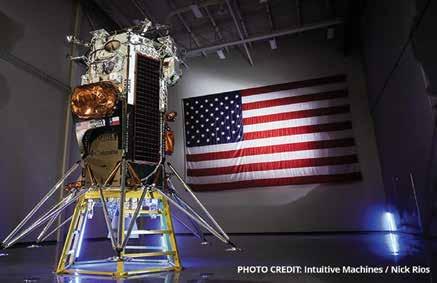
demonstrating precision landing, observing how rocket plumes and space weather interact with the lunar surface, and testing certain communication and navigation node capabilities for future autonomous navigation technologies.
Aitech provided the complete conduction-cooled hardware for the Nova-C avionics system, which can be used as both a payload controller and image data processor. Intuitive Machines utilized this dual SP0-S setup to run VxWorks RTOS and Linux to execute its time-critical software while processing video data streams down to a NAND flash storage module. This unique
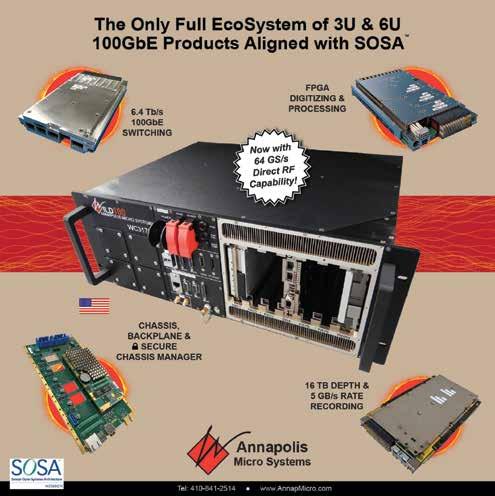
dual SBC system leverages RS-422, SpaceWire cameras, and NAND flash storage in an allin-one space-rated avionics system.
Ralph Grundler, Aitech’s Space Director, said, “We aim to support the most demanding space applications with computing and connectivity electronics systems while continuously anticipating and exceeding the needs and expectations of the space industry for not only Lunar but also LEO, GEO, and Deep Space applications. The Nova-C class lunar lander’s system exemplifies how Aitech is developing rugged space system solutions capable of providing reliable performance for the most unforgiving environments.”
Aitech’s space-rated SP0-S is a radiationtolerant 3U CompactPCI SBC developed to handle high-performance processing and enhanced memory storage in orbit. Aitech’s SP0-S architecture supports up to seven additional cards on the CompactPCI backplane, providing clock, arbitration, and interrupt servicing, including additional SP0-S SBCs as peripheral processors, as seen in the Nova-C lunar lander.
The S740 radiation-tolerant communications PMC is designed with 16 input and 16 output differential channels of RS-422 and utilizes the onboard FPGA logic to interface to external spacecraft sensors and devices. It is also designed to reduce bottlenecks with a protected onboard PCI Bus DMA controller for input and output data packet buffering.
The radiation-tolerant S730 SpaceWire PMC Card offers three SpaceWire ports with initiator and target capability and has provisions to add on RS422 serial interfaces and 32 GPIOs for complete system communication.
COTS Journal | March 2024 8
The INSIDE TRACK
OSS Wins U.S. Intelligence A.I. Project for Liquid Immersion-Cooled Storage Server at the Edge
One Stop Systems, Inc. has secured a pilot project to provide a liquid immersion-cooled data storage system for a deployable ground station. The project is expected to lead to follow-on production orders.
Procured through a global defense prime contractor, the win represents the first liquid immersion-cooled high-performance compute solution for a U.S. intelligence agency mobile ground station application and a new intelligence community end user for OSS.
The deployment will leverage OSS’ unique rugged mobile edge technology, consisting of the company’s Gen 4 PCIe® 3U-SDS configured as a high-speed NVMe data recording system that can deliver up to 52GB/s sustained storage bandwidth.
OSS will integrate two 3U-SDS units into a liquid immersion-cooled system, which will be a part of a deployable ground station at the edge. The custom storage accelerator system will be ruggedized for the harshest edge environments.
“This project, for a major government

Spectra Aerospace & Defense
Appoints Ray Munoz as New Chief Executive Officer
Spectra Aerospace & Defense, a global leader in the design and production of advanced

intelligence agency contracted through a prime contractor part ner, represents an expansion of our mission applications into the intelligence community, consistent with our growth strategies,” commented OSS VP of Sales Robert Kalebaugh. “It also demon strates our commitment to providing high throughput, ruggedized storage capabilities, and solutions directly impacting emerging Department of Defense platforms’ AI/ML mis sion objectives. We anticipate that this initial design win will lead to other deployments that require high speed, low latency compute accelerators and data acquisition solutions.”
The immersion-cooled technology solutions utilize non-conductive, chemically inert, non-corrosive fluids. These liquids are similar to water and fully immersed products like the 3U-SDS, where the liquid’s boiling point properties efficiently remove the heat from the electronics without using large heat sinks, fans, or liquid pumps. The absence of heat sinks allows for very compact rugged platforms and helps provide high performance and low noise in small form factors, which are vital product features for the edge.
The 3U-SDS system is powered by two Intel processors and 16 NVMe storage drives— an ideal configuration for high-speed data
rugged electronics solutions for aerospace and defense platforms, is excited to announce Mr. Ray Munoz’s appointment as its new Chief Executive Officer.
Mr. Munoz, with his impressive 25 years of leadership in the international aerospace and defense markets, has a well-established history of catalyzing growth, spearheading innovative products, and breaking ground in new markets. His extensive experience includes noteworthy positions such as CEO and Board Member of Safran Data Systems Inc., Divisional Senior Vice President of Business Development & Strategy at Ultra Electronics Maritime, and numerous pivotal leadership roles at L3 Technologies. Additionally, Mr. Munoz’s active-duty military experience provides him a critical insight into delivering highly technical solutions that meet the military’s most demanding operational challenges.
record, and store up to 960 terabytes of raw R.F. data signals onto high-speed NVMe SSDs.
The NVMe SSDs are securely encased in removable, encrypted drive packs, enabling easily expandable and transportable data storage. To upload massive amounts of collected data to the secure cloud, the drive packs can be easily transferred to SDS servers or Centauri storage expansion systems installed in in-ground stations equipped with high-bandwidth Internet connections.


JOURNAL Interested in getting your copy of Contact us; RTC Media 3180 Sitio Sendero, Carlsbad, CA. 92009 Phone: (949) 226-2023 www.rtc-media.com
9 COTS Journal | March 2024
The INSIDE TRACK
Bell Announces Weapon Systems Integration Lab
Opening of the Latest SIL to support continued flight technology advancement
Bell Textron Inc. announced the Grand Opening of its Weapon System Integration Lab (WSIL) in Arlington, TX. The state-of-the-art facility will aid in the safe, rapid, and efficient integration and test of a next-generation flyby-wire tiltrotor and mission systems using a modular open systems approach (MOSA) for the United States Army’s Future Long-Range Assault Aircraft (FLRAA).
As part of our commitment to deliver the
U.S. Army’s FLRAA capability to our nation’s warfighters, Bell is pleased to announce the opening of its latest systems integration lab,” said Ryan Ehinger, Bell’s Senior Vice President and Program Director, FLRAA program. “This dedicated SIL supports the application, verification, and validation of Bell’s innovative digital engineering approach and open architecture, playing a critical role in delivering outstanding operational performance and versatility to the U.S. Army.”
“We are grateful for our partnership with Bell, who has made Arlington the home of its Flight Research Center for nearly six decades. The Arlington Economic Development Corporation’s recent strategic investment
shows our city’s continued commitment to supporting innovation right here in our backyard,” Mayor Jim Ross said.
In 2021, Bell began constructing a new 47,000 sq. ft. facility to house future development programs at its Flight Research Facility in Arlington, TX. The FLRAA WSIL is Bell’s fifth-generation System Integration Lab at its Flight Research Center. This latest SIL facility supports end-to-end integration of our fly-by-wire systems with state-of-theart Avionics, Electrical, Hydraulic, Flight Controls, and Mission and Sensor Systems for multiple current and future programs, manned and unmanned.

Silynxcom Delivers $280,000 Repeat Order from Military Customer
The Customer’s purchase orders to date collectively amount to over $1 million
Silynxcom Ltd. announced it delivered approximately $280,000 worth of Clarus InEar Headsets to a military customer (the “Customer”) in a follow-up purchase order.
This is the second order Silynxcom has
received from the Customer for products from its advanced Clarus In-Ear Headset system family and the third order from the Customer overall. To date, the Customer’s purchase orders amount to over $1,000,000.
“Silynxcom continues strengthening its position as a leading innovative company in tactical communication solutions. Our customer base is rapidly increasing, with new companies and defense organizations from many countries worldwide ordering our prod-
ucts and expressing their satisfaction,” said Nir Klein, the Chief Executive Officer of Silynxcom.
Silynxcom’s unique in-ear sound protection headset system incorporates a proprietary in-ear microphone that allows “talking from the ear” technology combined with enhanced environmental hearing and sound compression technology that protects the user from loud noises, thereby protecting the user’s hearing.
COTS Journal | March 2024 10
The INSIDE TRACK
Intellian intensifies its partnership with the U.S. Navy as missions deploy with the ARC-M4 Block1
Intellian Technologies Inc. has intensified its collaborative partnership with the U.S. Navy.
The U.S. Navy has successfully deployed the cutting-edge NDI/COTS ARC-M4 Block 1 tri-band antenna for operational use in the fleet. The system provides for electronically switchable, simultaneous operations on both X- and Ka-bands and was designed to maximize the value of the WGS constellation for the Navy warfighter. The ARC-M4 Block 1 is the second WGS terminal in Intellian’s family of highly capable and extensible WGS-certified terminals.
The ARC-M4 Block 1 is the fleet’s first operationally deployed U.S. Space Force-described hybrid terminal. It was recently type-approved for SES O3b mPOWER and Viasat’s Global Xpress (G.X.) High Capacity Military Ka-Band payload. Compared to legacy Navy SHF systems of similar SWAP, such as the CBSP Unit Level Variant (ULV) terminals and the SHF Navy Multiband Terminal (NMT), it presents an unprecedented improvement in overall R.F. performance, capability, and mission flexibility for the warfighter by offering “no-compromise” access to the relevant GSO and NGSO assets.
Additionally, Intellian is engaging with the wider U.S. DoD community to make the ARC-M4 Block 1 compatible with emerging Military Ka-Band NGSO capability in the LEO and HEO orbits.
Intellian’s partnerships with key leading NGSO/GSO providers, such as Eutelsat OneWeb, SES, and Viasat, has enabled Intellian to design the ARC-M4 Block 1 to be ready for these constellations as they reach operational maturity. This benefits the U.S. Navy and the relevant DoD community by eliminating the bottlenecks and costs associated with enabling terminals to access satellite assets of interest.
The ARC-M4 Block 1 is designed for rapid deployment, leveraging Intellian’s expertise learned from years of rapid installs for cruise and oil and gas customers, which typically install in five days or less, even for
larger user terminals such as Intellian’s high capacity 2.4m tri band terminals. The AptusNX antenna control unit’s industry-best user interface makes training quick, simple, and operations easy to use.
The ARC-M4 Block 1 is in volume production today, and meets MIL Standards 188-164c, 461G, 464D, 810H, and 901E.

Maryland-based facility, its Advanced Development Center (ADC), to support the burgeoning needs of the U.S. DoD community.
To comply with Navy C2 requirements, Intellian’s PrePlanned Product Improvement (P3I) strategy will expand the list of natively supported NGSO constellations for the ARC-M4 Block 1.
As part of its steadfast and continuing commitment to the U.S. warfighter and its allies, Intellian has launched an initiative to leverage its industry-leading global supply chain management to ensure unprecedented, tightly controlled configuration management that meets the stringent needs of the U.S. DoD customers and other allied nations. Intellian has also expanded its R&D footprint in the U.S. by opening its
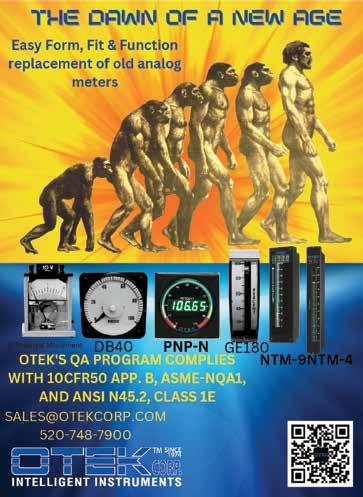
11 COTS Journal | March 2024
The INSIDE TRACK
Keysight and ETS-Lindgren Deliver First Narrowband Non-Terrestrial Networks Over-The-Air Test Solution
The joint solution was developed to assess the transmitter/receiver performance of devices supporting narrowband non-terrestrial networks under over-the-air conditions


provides a key enabler to accelerate the mobile ecosystem’s rapid deployment ambitions for non-terrestrial networks
Keysight Technologies, Inc. and ETS-Lindgren announce an industry-first over-the-air (OTA) test solution for devices supporting the narrowband non-terrestrial networks (NB-NTN) technology.
Non-terrestrial networks (NTN), a 3GPP Release 17 (Rel-17) feature, enables cellular communications to be delivered by satellite, providing secure, reliable, and high bandwidth coverage to isolated locations globally. The initial technology enabled by NTN is the narrowband Internet of Things (NB-IoT), which allows many new use cases, including asset tracking, remote monitoring, and emergency services. This enables mobile network operators to cover a wider geographical area and a more significant number of subscribers.
Working in close partnership, Keysight and ETS-Lindgren developed a joint OTA test solution for measuring and validating the transmitter/receiver performance of devices supporting NB-NTN. These tests allow device manufacturers to assess real-life performance to ensure they meet consumer expectations and the requirements of network operators and regulators. The solution will also support the forthcoming CTIA OTA test requirements for NTN devices.
The combined solution comprises Keysight’s UXM E7515B NTN software, ETS-Lindgren’s OTA test chambers, and EMQuest Antenna Measurement Software. The Keysight NTN software runs on the Keysight E7515x family of UXM 5G Wireless Test Platforms. It emulates terrestrial and satellite networks, including satellites in low, mid, or geo-stationary/synchronous orbits, to test the effects of Doppler shifts. The built-in channel emulation capabilities of the UXM 5G also allow the performance of devices to be assessed under real-world channel fading conditions in a lab environment. Along with ETS-Lindgren’s OTA test chambers and EMQuest Antenna Measurement Software, the fully integrated solution allows the transmitter and receiver performance of NTN devices to be assessed, including measurements such as Total Radiated Power (TRP) and Total Isotropic Sensitivity (TIS).
COTS Journal | March 2024 12
The INSIDE TRACK
American Rheinmetall Vehicles
Conducts Live-Fire Demo and Continues to Deliver Autonomous Ground Vehicles to the U.S. Marine Corps for Testing, Training, and Deployment
American Rheinmetall Vehicles (Sterling Heights, MI) and Rheinmetall Canada have successfully conducted a live-fire capability demonstration for the U.S. Marine Corps (USMC) in Fort Clinton, Ohio, to highlight the unique capabilities of the Rheinmetall Mission Master SP autonomous, unmanned ground vehicle (A-UGV) paired with the Fieldranger Remotely Controlled Weapon Station (RCWS). This armed variant of the Rheinmetall Mission Master SP provides Marines with a variety of remotely operated capabilities, including armed reconnaissance, sentry overwatch, fire support, flank security, screening capability, and more. Having completed numerous test and evaluation events with the Mission Master SP, American Rheinmetall Vehicles continues to deliver ground-breaking advancements in A-UGV systems to the USMC. It first made deliveries to the USMC
in early 2023, and several follow-on orders for A-UGVs are proceeding in 2024. The platforms have the potential to enhance the way Marines fight substantially.
Mission Master SPs furnished by American Rheinmetall Vehicles were also extensively tested by the USMC during the Talisman Sabre Exercise (TS23) in Queensland, Australia, in the summer of 2023 and as part of the Apollo Shield exercise at Marine Corps Base, Twentynine Palms, California, in fall 2023, both in support of Marine Corps Warfighting Lab (MCWL) evaluations. The Mission Master SPs’ participation supported MCWL’s one-year, crawl-walk-run, bilateral effort to test equipment capabilities and evaluate tactics, techniques, and procedures of Infantry squads equipped with A-UGVs. Tasks the Mission Master SP A-UGVs took on during the exercises included casualty evacuations (CASEVAC), resupply missions, fully autonomous road marches reaching ranges up to 50 kilometers, and operating in Military Operations in Urban Terrain (MOUT) environments. Feedback from the Marines and their Commanders drove A-UGV design modifications and solidified the benefits of A-UGVs among Marines.
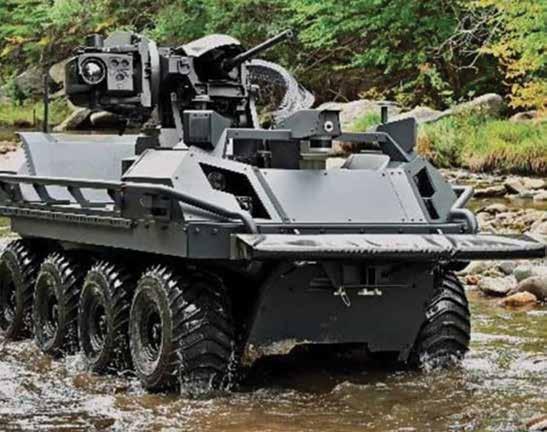

13 COTS Journal | March 2024

Enhancing Tactical Communications at the Edge with Sealevel Products: A Strategic Advantage for Military Operations
Enhancing Tactical Communications at the Edge with Sealevel Products: A Strategic Advantage for Military Operations
SPECIAL FEATURE
COTS Journal | March 2024 14
By John Reardon, Editor - COTS Journal
Introducing the Relio R1 Rugged
In modern warfare, where information is power and agility is paramount, tactical communications are pivotal in ensuring mission success and operational superiority. The United States Navy (U.S. Navy) and its joint forces have long recognized the criticality of robust, reliable, and secure communication networks, especially in dynamic maritime environments. With the evolution of technology and the advent of distributed maritime operations, the need for advanced communication solutions at the Edge has become increasingly pronounced.
Amidst this backdrop, the integration of commercial, off-the-shelf (COTS) hardware, like the Relio R1 Rugged, has emerged as a cost-effective and efficient approach to meeting the demands of contemporary warfare. Sealevel is known for its innovative and dependable products tailored for mission-critical applications. Let’s delve into the benefits of leveraging Sealevel products within tactical communications, particularly in the context of initiatives such as the Battle
Force Tactical Network (BFTN) program and Expeditionary Mobile Base Special Operations Forces (ESB SOF).
L3 Systems Co. recently secured a substantial contract from the United States Navy for the Battle Force Tactical Network (BFTN) program. Valued at $ U.S. 41 million, this indefinite-delivery/indefinite-quantity contract underscores the importance of ruggedized COTS solutions in modern military communications. As a key component of the BFTN program, Sealevel has played a crucial role in the high-frequency internet protocol and subnet relay hardware and has since released other COTS solutions to address the needs of the space.
The recently developed Relio R1 Rugged is a compact, rugged industrial computer designed to excel in similar environments. Its robust aluminum enclosure ensures durability, protecting against dust, moisture, and extreme temperatures. The Relio R1 Rugged boasts versatile mounting options, allowing seamless
integration into diverse applications, from maritime vessels to military vehicles.
Underneath its rugged exterior lies a powerful Intel processor, offering highperformance computing for mission-critical tasks. With a wide range of connectivity options, including Ethernet, USB, and serial ports, the Relio R1 Rugged facilitates seamless communication with peripheral devices and network infrastructure. Its fanless design minimizes noise and reduces the risk of mechanical failure, enhancing reliability in harsh operating conditions.
The Relio R1’s solid-state storage ensures fast boot times and reliable operation, while optional expansion slots enable customization to meet specific application requirements. Whether deployed for surveillance, communications, or automation, the Relio R1 delivers unmatched reliability, performance, and versatility, making it ideal for rugged computing needs in challenging environments.
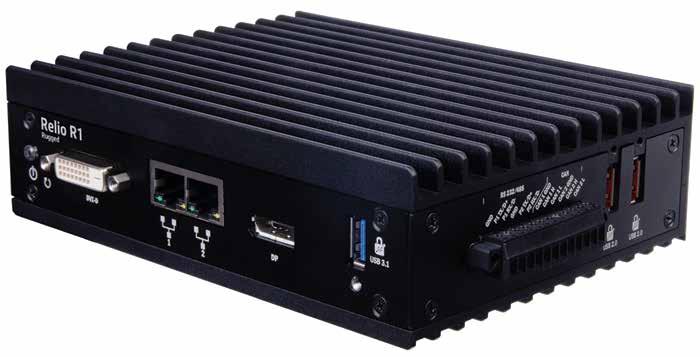
The Relio™ R1 compact rugged industrial computer is designed for applications that demand powerful processing capabilities, wide operating temperature range, and DIN Rail compatibility, while designed to exceed military specifications for shock & vibration.
15 COTS Journal | March 2024

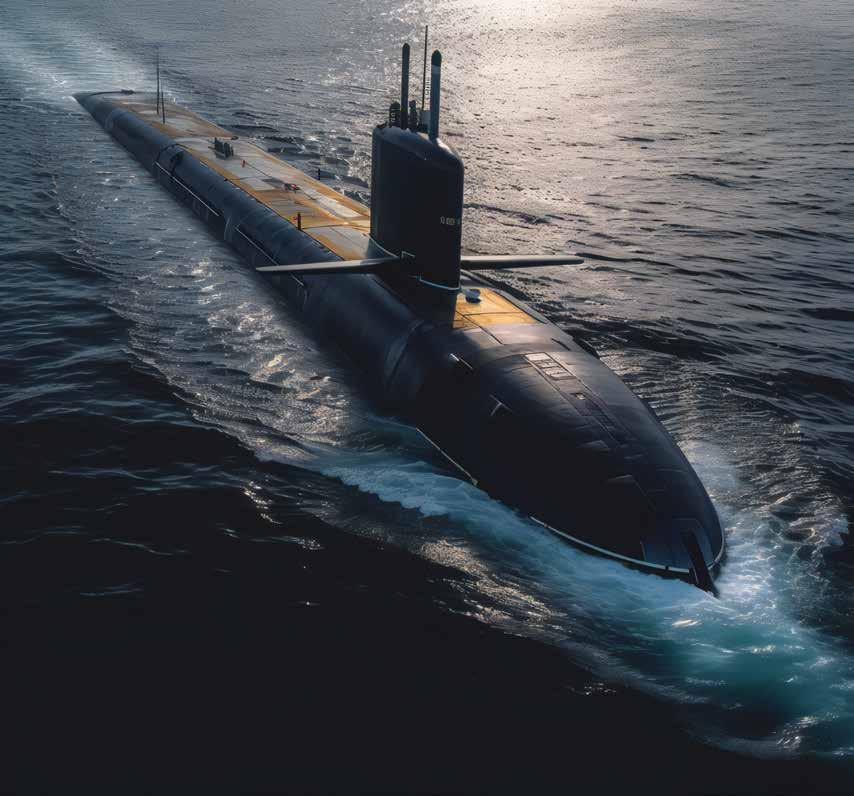
Evolve or Perish through System Monitoring
By Dr. Otto Fest, President and Founder of Otek




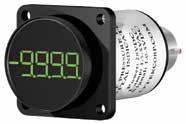
ADVERTORIAL
For decades, OTEK Corporation’s engineers have been dedicated to enhancing and modernizing critical systems, especially in the context of military applications. The challenge often arises when aging meters and displays, abandoned by their original manufacturers, pose a significant risk, akin to a ticking time bomb. OTEK’s mission is clear: retrofit existing infrastructure with cutting-edge solutions that seamlessly integrate into legacy systems, providing modern and reliable user interfaces.
In the military and defense sector, where time is of the essence, the need for swift, cost-effective, and secure solutions is paramount. The high capital expenditure and stringent regulatory oversight associated with major projects like nuclear power submarines demand innovative alternatives. OTEK’s expertise, initially developed in the energy sector, has been extended to other industries, with a focus on providing plug-and-play solutions that meet the specific demands of each application. By using patented Powerless technology, OTEK delivers direct replacements for original components or upgrades to more advanced digital solutions, all without the need for costly and time-consuming recertification.
In military and defense applications, where the cost of downtime can be measured with loss of life, waiting weeks or months for a solution is not an option. OTEK’s solutions offer a low-cost, cybersecure, real-time metering option that seamlessly fits into existing systems without the need for rewiring. Moreover, OTEK provides the convenience of a spares program, ensuring immediate availability of critical components. This approach eliminates the prohibitive costs and potential security risks associated with extensive system alterations while guaranteeing decades of reliable service.
OTEK’s diverse product range encompasses digital panel meters, controllers, batch counters, process loggers, and bar graph indicators, all designed to cater to the unique needs of military contractors and defense applications. The company’s goal is to work closely with clients to identify the best course of action for their instrumentation and control needs and supply products that surpass every prerequisite and requirement. In essence, OTEK’s objective is to replace aging analog and digital meters with highquality, drop-in replacements that seamlessly integrate into existing systems, safeguarding critical military operations.
In the early 1980s, OTEK was commissioned by the United States Air Force to develop the first MIL-SPEC Meter to replace
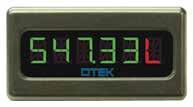
extensively used meters in various airframes, including the C-135 Stratotanker. OTEK’s rich history in supporting advances in space exploration, nuclear energy, and critical system monitoring is underscored by numerous patents and a firm commitment to never compromise on system reliability.
OTEK’s meters, with a calculated Critical Mission Time Between Failures (CMTBF) of more than 40 years, reduce the need for costly spares inventory due to their plug-and-play installation. Replacing a meter takes mere minutes, with no specialized expertise required, while maintenance and calibration can be completed in under five minutes. OTEK leverages open and MIL standards to ensure seamless integration across a wide spectrum of applications, from space missions to maritime operations.
By harnessing the latest LED technologies, OTEK offers an array of display options that integrate seamlessly with existing panels while providing advanced capabilities to convey critical information. These displays come in various digital formats, including digital or analog gauges, bar graphs with alarms, or traditional meters, ensuring that clients have a range of choices to suit their specific needs.
Drawing from decades of experience, OTEK’s engineers have recently introduced the NTM product line, a third-generation digital metering solution designed to replace analog meters. OTEK’s patented loop-power technology enables 2-wire analog meter replacements with no external power requirements. With a vast array of products designed to address end-of-life concerns, OTEK continues to evolve its solutions to meet the changing needs of its clients.
In summary, OTEK has established itself as a premier metering company in critical applications, with a strong focus on military and defense sectors, offering reliable, retrofit solutions that guarantee the safety, accuracy, and efficiency of critical systems.


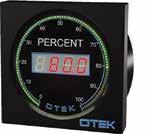
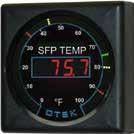

4016 E. Tennessee St. • Tucson, AZ 85714 USA Sales@otekcorp.com 520-748-7900 • Fax: 520-790-2808 • 877-227-6835
Reliability in Harsh Environments:
Sealevel’s Relio R1 Rugged thrives in the most challenging operational conditions, characterized by temperature, moisture, vibration, and electromagnetic interference extremes. Whether deployed on naval vessels, submarines, or aircraft, Sealevel ensures uninterrupted communication capabilities, enhancing situational awareness and operational effectiveness.
Versatility and Scalability:
The modular design of the Relio R1 Rugged enables seamless integration and scalability, catering to evolving mission requirements and diverse platforms. Whether expanding network connectivity, integrating new peripherals, or adapting to emerging technologies, the goal is to offer flexibility and future-proofing, essential for maintaining tactical superiority in dynamic operational environments.
Compatibility and Interoperability:
Interoperability is paramount in joint and coalition operations, where seamless communication between disparate systems is essential for mission coordination and collaboration. Sealevel’s adherence to industry standards and protocols ensures compatibility with existing infrastructure and interoperability with legacy systems, facilitating smooth integration and enhancing overall operational efficiency.
Secure and Resilient Communication:
In an era marked by cyber threats and information warfare, ensuring the security and resilience of communication networks is paramount. The Relio RI can be configured for robust encryption algorithms, secure protocols, and built-in cybersecurity features to safeguard sensitive information and mitigate potential vulnerabilities, thereby bolstering operational security and mission assurance.
Cost-Effectiveness and Time-toDeployment:
Leveraging COTS solutions translates to significant cost savings and reduced time-todeployment compared to bespoke, proprietary systems. By harnessing commercial-offthe-shelf hardware and software, military organizations can expedite procurement processes, minimize development cycles, and allocate resources more efficiently, ultimately enhancing operational agility and readiness.
Edge Computing in support of JADC2:
As the proliferation of edge computing grows dynamically, devices at the Edge reshape the landscape of military operations. Products offering seamless integration are in ever-
increasing demand. By harnessing the power of edge intelligence, military commanders can derive actionable insights in real-time, optimize resource allocation, and make informed decisions on the battlefield, thereby gaining a decisive edge over adversaries.
Sustainment and Lifecycle Support:
Beyond initial deployment, a commitment to providing comprehensive sustainment and lifecycle support, ensuring the longevity and
themselves in the place of the warfighter distinguish Sealevel products as indispensable assets within tactical communications at the Edge. From ensuring enhanced reliability and interoperability to fortifying security measures and optimizing cost-effectiveness, Sealevel’s ruggedized COTS solutions cater to the unique demands of modern warfare with unparalleled precision.
As military organizations confront the

reliability of deployed systems throughout their operational lifespan, is a must. With dedicated technical support, timely firmware updates, and product refresh programs, Sealevel empowers military organizations to adapt to evolving threats and maintain peak performance in dynamic operational environments.
In conclusion, the meticulous attention to detail, adherence to open standards, and unwavering commitment to putting
intricacies of contemporary battlefields, integrating Relio R1 emerges not merely as a choice but as strategically beneficial. By empowering warfighters with resilient, agile, and future-ready communication capabilities, Sealevel equips them with the tools needed to navigate the complexities of the battlefield confidently. It continually reaffirms its commitment to enhancing mission success and operational superiority for military forces at the forefront of defense and security.
COTS Journal | March 2024 18


Space Lasers Aiming Towards Next Leap in Global Communications
SYSTEM DEVELOPMENT
COTS Journal | March 2024 20
By Rick Williams, Kaman Precision Products
Space lasers are transforming the world. Not the far-off future of science fiction, but the universe of how data and communications flow today — everywhere from deep space missions to countless applications here on earth, including consumer internet services, military operations, and banking transactions.
Lasers can transmit vast amounts of data over great distances at the speed of light, 100 times faster than previously possible in space. The narrowness of the light beams makes laser communication remarkably efficient. The highly focused light is aimed at the receiver, resulting in minimal beam divergence and signal loss and allowing for reduced power consumption.
Staying on Target
Indeed, this narrowness of the laser beam also presents daunting technological challenges. In space laser communications, impeccable precision is needed to align transmitters and receivers across vast distances as the terminals move at varying speeds and directions — a level of accuracy comparable to hitting a three-point basketball shot from 100 miles away.
Engineers have addressed these challenges by developing fast steering mirrors (FSM) controlled with extremely sensitive sensors. These systems keep the beam precisely on target for satellite-to-satellite and ground-tosatellite links and deep-space communication, facilitating accelerated growth in the flow of data around the globe.
The Galactic Network
These capabilities — laser communications with FSM tracking — are bringing us closer to what might be called the “Galactic Internet.”
That was the imaginative term coined in the early 1960s by J. C. R. Licklider, the first director of the Information Processing Techniques Office (IPTO) at the Pentagon’s ARPA, to describe the possibility of a digital “network” open to all that would serve as “the main and essential medium of informational interaction for governments, institutions, corporations, and individuals.”
ARPANET became the first wide-area packetswitched network with distributed control and proved instrumental in shaping modern computer networking and the internet.
Copper Couldn’t Satisfy the Insatiable Demand for Bandwidth
In the early days of the internet, most data was transmitted over copper cables, taking advantage of ubiquitous telephone networks. However, electrical transmission over copper suffers from signal attenuation due to resistance in the conductor and dielectric losses.
As the internet evolved from text-based emails to images, videos, and games, the standard 56.6-baud dial-up modems became obsolete, and internet service providers (ISPs) and backbone networks needed new transmission methods to keep up with the tremendous surge in data traffic.
Fortunately, as computer scientists were creating the internet, the field of photonics was developing a method of using light to transmit data much faster and over much longer distances than what is possible with electricity conducted through copper wires.
Fiber Optics Enabled the Growth of the Internet
The first continuously operating heliumneon gas laser was demonstrated in 1960, and a decade later, scientists at Corning Glass Works
For all its benefits, optical communications still face several challenges. Unlike radio communications, which can be sent out in a broad beam blanketing target areas with its signal, optical communications are sent in a relatively narrow beam pointed directly at a receiver. When broadcasting from thousands or millions of miles away, an optical communications telescope pointing must be extremely precise. A deviation of even a fraction of a degree can result in the laser missing its target entirely.
https://www.nasa.gov/directorates/ heo/scan/opticalcommunications/ challenges
invented ultra-transparent glass that could be mass-produced into low-loss optical fiber. By 1977, fiber optics began to carry traffic over public telephone networks. and in 1986, Sprint deployed the first nationwide 100% digital fiberoptic network.

21 COTS Journal | March 2024
Year of launch of all active satellites. Source of data: Union of Concerned Scientists.
Optical fibers can transmit up to 60 Terabits per second, more than 700 times faster than copper. And the data quality is superior because the optical signal is not subject to electromagnetic interference and radiofrequency interference (EMI/RFI), crosstalk, and impedance problems that cause signal distortion and loss with copper.
A watershed moment came in 1986. The invention of the erbium-doped fiber amplifier (EDFA) significantly increased the distance an optical signal could be transmitted before requiring an electronic repeater, making fiber optics practical and economical for intercontinental undersea cables. Previously, submerged copper cables operated at only 140 megabits per second and required powered electronic repeaters at frequent intervals.
The first transatlantic fiber optic cable went into operation in 1988 — a year before Tim Berners-Lee proposed what became the World Wide Web, causing a further explosion of internet traffic. Today, submerged optical cables carry 95% of the world’s data traffic. Each single fiber has a bandwidth in excess of 1 terahertz, one thousand times greater than what is possible with copper wire.
Free Space Optical
Fiber optics enables significantly higher data transmission rates, over longer distances, compared to copper wire. But fiber optics is limited by the length of the strand of fiber. What if the benefits of optical data transmission could be untethered from this physical limitation, extending thousands of miles through space?
Laser communications, also known as Free Space Optical (FSO) communications, utilizes much of the technology developed for fiber optics to wirelessly transmit data through air, vacuum, or outer space. FSO is reliable over vast distances when the light propagates in space for inter-satellite and deep space links.
Unfortunately, here on Earth, atmospheric factors such as fog, rain, dust, heat, and even birds pose significant challenges to Free Space Optics (FSO) technology. These factors lead to signal failures and unacceptable error rates and limit the feasibility of long-distance point-topoint optical links between terrestrial terminals.
In the early 2000s, companies like Terabeam, AirFiber, and CableFree invested significant sums in FSO as an alternative to fiber optics. However, none of these ventures could overcome the challenges posed by atmospheric
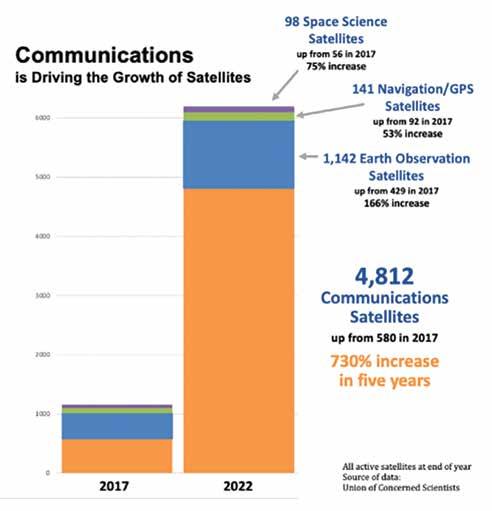
conditions to establish commercially viable services.
Terrestrial laser internet service is experiencing a resurgence, with deployments in 13 countries, including Australia, Kenya, and Fiji. In June 2023, Alphabet, the parent company of Google, unveiled its ambitious plans for largescale implementations in regions of India and Africa, where fiber optics is difficult to deploy, aiming to provide up to 20 Gbps bidirectional throughput within a 20 km range.
Space Lasers Vastly Outperform RF
These distance limitations do not exist in the “free space” beyond the Earth’s atmosphere. Lasers perform exceptionally well over great distances, in the vast emptiness of space, far more efficiently than what is possible using radio frequencies (RF).
Before the advent of FSO, all communication in space used radio and microwave bands, regions of the electromagnetic spectrum with the longest wavelengths and lowest frequency.
Over the past five to ten years, satellite cost performance has, in some instances, improved more than 1,000 times, and satellites produce and transport much more data than ever before. There are few parallels for a disruption of this magnitude, except the transition from mainframe to desktop computing in the 1970s and 1980s.
McKinsey & Company,
The role of space in driving sustainability, security, and development on Earth, May 2022.
COTS Journal | January 2024 14
COTS Journal | March 2024
No More RF Red Tape
Before you even start thinking about launching your satellite you need to apply for a license from every country you want to send an RF beam down to. You have to pay the costs associated with each licensing regime. Then you have to wait. And wait…. Laser communication is not regulated by the International Telecommunication Union and it can be used without restrictions and does not require costly licenses. The reason for this is that its inherent small beam size avoids interference issues and renders any restrictive regulation in the future highly unlikely.
https://mynaric.com/technology/ licence-free/
NASA beamed TV signals from the moon using the S band (2–4 GHz), and later the X band (8–12 GHz) and the Ka band (27–40 GHz) provided faster transmission rates. NASA’s Deep Space Network currently achieves speeds up to 50 Mb/s with the Ka band.
The low transmission rates are not the only disadvantage of RF: radio signals spread out as they travel, causing two additional problems. The first is the overcrowding of the RF spectrum which causes the overcrowded RF airwaves causes interference, interception, or jamming, and the scarcity of available spectrum severely restricts the expansion of services.
The second problem is that beam divergence causes significant attenuation of the RF signal. The farther the distance, the weaker the received signal. To compensate, transmitters and receivers are enlarged, and power consumption increased, placing costly demands on satellites and spacecraft. RF ground stations have antennas as large as 230 feet (70 meters) in diameter.
Advantages of Space Lasers
Laser communications offer an effective solution to these challenges and limitations of RF.
Bandwidth – The primary advantage of laser communications compared to traditional RF
signals is a dramatic increase in bandwidth. Space lasers use non-visible infrared radiation (IR) portion of the electromagnetic spectrum has frequencies ranging from about 300 gigahertz (GHz) up to about 400 terahertz (THz). The higher the frequency, the more data is encodable in the waveform, resulting in effective bandwidth increases of 10 to 100 times compared to RF.
Low Latency – Faster doesn’t just refer to the increased data transmission per second. Laser communications also achieve a significant reduction in latency with near-instantaneous data transfer with delays 10-20 milliseconds, compared to the hundreds of milliseconds experienced with RF.
No Spectrum Congestion – The short wavelengths (less than 0.1 centimeters, compared to RF wavelengths of 0.8 to 15 cm) and the highly focused beam frees FSO from the many headaches and limitations of spectrum overcrowding. Laser communications links do not interfere with each other, and therefore the possibilities for expanding FSO in space are practically unlimited.
SWAP – Another important benefit of the
tightly focused beam is that laser light does not spread out the way radio waves do, allowing optical signals to maintain their strength over great distances. Less beam divergence and attenuation mean more of the transmitted power is captured by the receiver and less power is wasted. According to NASA, “optical communications provides decreased size, weight, and power requirements. A smaller size means more room for science instruments. Less weight means a less expensive launch. Less power means less drain on the spacecraft’s batteries.” These benefits extend to equipment on the ground: laser communications receivers can be up to 44 times smaller than current radio antennas.
Security – The narrow beams also make laser signals extremely difficult to intercept. Moreover, space lasers use light and photonics, and therefore Quantum Key Distribution (QKD) can add unmatched levels of security to these communications.
Revolutionary New Services
During the era of RF space communications, most data traffic heavily relied on geostationary (GEO) satellites. Positioned at an altitude of 35,786 km (22,236 mi) to maintain fixed

23 COTS Journal | March 2024
Average of launch mass of all active satelllites. Source of data: Union of Concerned Scientists.
locations above the equator, these satellites offered stability and efficiency by ensuring coverage across a significant portion of the Earth’s surface with just two or three satellites. However, these GEO satellites were large and costly, and the RF transmissions over such long distances resulted in significant latency.
The alternative, low earth orbit (LEO) satellites at altitudes of 60 to 2,000 km (99 to 1,200 mi), reduces signal propagation delay, but many more LEO satellites — several hundreds or thousands of satellites — are required to provide continuous coverage depending on the altitude. The velocity of LEO satellites, moving at around 17,000 miles per hour relative to a fixed point on the Earth, adds considerable complexity to maintaining data communications links.
Laser technology significantly enhances the functionality and economic viability of the various types of satellite systems, unlocking new possibilities and expanding the realm of what is feasible. GEO satellites can now provide high-speed, low-latency communications, and the radical improvements in SWAP of laser compared to RF systems make large constellations of LEO satellites more economically viable to build and launch.
Networking LEO and GEO
Optical communications also facilitate the networking between satellites at different altitudes to achieve efficiencies and optimize specialized tasks. For example, the U.S. National Defense Space Architecture (NDSA), which has since been renamed the Proliferated Warfighter Space Architecture (PWSA), is developing a network topology composed of two separate constellations: the Transport and Tracking layers, connected by optical links.
The Transport Layer is a resilient mesh network in LEO that allows information to flow quickly and securely around the globe and connects to ground stations. Mesh satellite networks provide resilience because data can be rerouted if one satellite is compromised or destroyed. The second constellation, the Tracking Layer, does remote sensing and observation, with infrared sensors to spot and track missile threats.
Another example of using laser links to network LEO and GEO satellites is the SpaceDataHighway (SDH), a public-private partnership between the European Space Agency and Airbus. The commercial service utilizes the European Data Relay System (EDRS) to provide high bandwidth capability to LEO satellites and airborne platforms by means of optical communications via the EDRS-A and

EDRS-C geostationary satellites and ground stations in Europe.
Proliferated Commercial Satellite Constellations
Starlink, an ambitious project initiated by SpaceX, has made notable strides in its mission to provide high-speed internet to every corner of the globe. As of July 2023, 4,487 Starlink satellites are operating in low Earth orbit, with the newest versions of the satellites networked to each other with lasers. SpaceX anticipates the total number of satellites in the Starlink network to grow to between 12,000 and 42,000 eventually.
SpaceX founder Elon Musk tweeted last year, “Laser links in orbit can reduce long-distance latency by as much as 50%, due to higher speed of light in vacuum & shorter path than undersea fiber.”
The Starlink project is groundbreaking and transformative, but it is not without competition. One of the biggest competitors is OneWeb, a UK-based company that also aims to build a satellite network for global broadband service. Another formidable rival is Amazon’s Project Kuiper, which plans to deploy over 3,000 satellites for similar purposes.
Furthermore, China’s state-run space agency is also working on a global broadband service called Tianlink. Each of these competitors brings unique strategies and resources to the table, thereby contributing to an increasingly dynamic and competitive landscape in satellite-based internet services.
Aiming the Narrow Laser Beam
All these developments depend on the remarkable quality of laser light — the extraordinarily straight and narrow beam of light that can be focused on a distant target, transmitting data at incredible speeds and low
latency, with minimal signal loss due to beam divergence.
And yet, it is the narrowness of the laser that makes it so difficult to acquire and maintain a line-of-sight link over distances of thousands of kilometers.
Aiming the transmitter and receiver is challenging due to the extreme precision required and because the system must quickly and smoothly adjust as the host satellites and spacecraft move at high velocity in different directions relative to each other and to ground stations. And the high-precision components must reliably stand up to the rigorous demands of space launches and the harsh space environment.
Fast steering mirrors require precision position data to rapidly adjust mirror position, Figure

COTS Journal | March 2024 24
1:
which is usually actuated by electromagnetic voice coils. Extremely sensitive sensors can accurately measure the mirror position with extremely fine resolution in the sub-micron range.
The system is designed so that the performance of the sensors remains unaffected by the severe temperature fluctuations in the space environment. As shown in Figure 1 on previous page, electronically matched sensors, using eddy current technology, are positioned in pairs on opposite sides of the pivot point of the mirror and equidistant from this point.
The sensor-to-target relationship is such that as the target moves away from one sensor, it simultaneously moves towards the other an equal amount. The two pairs of sensors are positioned in two axes set perpendicularly to provide precise x-y tilt/tip position data. Operating in differential mode, the sensors eliminate or reduce common mode effects, such as piston action, and signal noise.
Taking Aim at the Future
Kaman Precision Products, through its
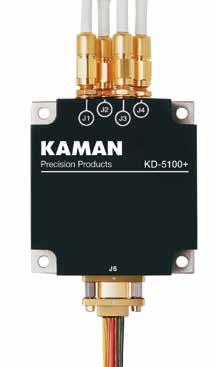
Measuring line of business, developed its line of differential position measuring systems over 30 years ago. Kaman has continually refined the performance capabilities of these renowned products to meet the increasing requirements of the space and defense markets. The product line now boasts three exceptional products
Kaman’s KD-5100+ differential system offers precision measurement of a dual axis fas steering mirror that makes point and tracking possible. The KD-5100 has space level heritage on a number critical platforms along with relianility data that includes radiation levels typical of 10 years on orbit.
including the KD-5100 family, with over 100krad TID capability and a rich 3-decades space heritage including the Mars 2020 Rover, as well as its COTS version, the DIT5200L, a low noise, affordable LEO-capable system, and our new digital KD-5690 system. Learn more at kamansensors.com/industry/space/.

The sensor-to-target relationship is such that as the target moves away from one sensor, it simultaneously moves towards the other an equal amount.
25 COTS Journal | March 2024
COT’S PICKS
Empowering Military Operations: CORE Systems unveils the Advantages of their new Rugged Cisco C220 M7 Server
In the realm of military operations, where reliability, performance, and resilience are paramount, the Rugged Cisco C220 M7 Server stands as a beacon of excellence. Tailored to thrive in the harshest environments, this server is not just a piece of hardware; it’s a dependable ally for mission-critical tasks. Let’s delve into the myriad applicational benefits that the Rugged Cisco C220 M7 Server brings to the table.
Robust Performance in Challenging Environments:
The short-depth design of CORE Systems is not just a matter of convenience; it’s a strategic advantage. Tested rigorously to military standards, this server boasts unparalleled durability, ensuring unwavering performance despite adversity. This server remains steadfast from extreme temperatures to high humidity, from shock and vibration to salt and fog, making it an indispensable asset in demanding military deployments.
ployment options. Moreover, with support for up to 3 PCIe 4.0 or 2 PCIe 5.0 slots and storage capability for up to 10 SAS/SATA or NVMe disk drives, this server adapts effortlessly to diverse operational requirements.
Streamlined Management and Automation:
Efficiency is key in military operations, and the Rugged Cisco C220 M7 Server doesn’t disappoint. Leveraging Cisco for centralized management and automation, this server simplifies administrative tasks, enhances visibility, and optimizes resource utilization. Whether deployed in remote locations or within a centralized data center, this server empowers military personnel with streamlined operations and enhanced control.
Compact Yet Capable:
Despite its compact form factor, the CORE solution packs a punch. Standing at 3.50 inches in height and weighing 40 lbs, its space-saving design doesn’t compromise performance or reliability. With dimensions of 24.00 inches in depth and 17.00 inches in width, this server is a testament to engineering excellence, offering maximum functionality in minimal space.

Powering Military Operations with Cutting-Edge Technology:
Equipped with the latest Intel Xeon Scalable CPUs, the Rugged Cisco C220 M7 Server delivers uncompromising performance tailored to military applications’ unique demands. With up to 32 DDR5 DIMMs offering a capacity of 4TB, this server provides the computational power and memory scalability required for complex data processing and analysis tasks essential for military operations.
Versatility and Integration:
The Rugged Cisco C220 M7 Server’s versatility extends beyond its robust design and powerful hardware. This 2U server can seamlessly integrate into existing infrastructure or operate as a standalone unit, offering flexibility in de-
Conclusion:
In the fast-paced world of military operations, having reliable and resilient infrastructure is non-negotiable. The CORE Systems Rugged Cisco C220 M7 Server exceeds expectations, offering unparalleled performance, durability, and versatility in challenging environments. From its short-depth design to its integration capabilities and streamlined management, this server is not just a piece of hardware; it’s a force multiplier, empowering military personnel to accomplish their missions with confidence and precision.
CORE Systems core-systems.com
VITEC Launches the MGW Diamond-H Compact 4K HDMI Encoder
VITEC, a market-leading provider of IPTV, video streaming, and digital signage solutions, is launching the MGW Diamond-H 4K HDMI encoder to enhance its broad portfolio of HEVC further encode and decode products.
“VITEC is proud to introduce the MGW Diamond-H, a powerful compact 4K HDMI Encoder demonstrating our commitment to innovation and meeting the evolving needs of our customers,” says Richard Bernard, Head of Product Management, at VITEC. “With its impressive encoding capabilities, seamless integration features, and Power over Ethernet support, the MGW Diamond-Hopens up new possibilities for IPTV distribution and video contribution across various industries.”

The MGW Diamond-H, a portable 4K HDMI Encoder, is a significant addition to VITEC's portable HEVC encoder product line, setting a new standard for quality, efficiency, and integration. With the ability to encode up to 4 channels from two HDMI inputs, the MGW Diamond-H empowers users to capture and stream content with unparalleled quality and minimal latency.
The unit is designed to facilitate integration into existing setups. Featuring an HDMI loop through, the MGW Diamond-H ensures a smooth workflow and enhanced connectivity with existing video equipment. The MGW Diamond-H can be powered via Power over Ethernet for optimal reliability and power efficiency, streamlining installations and reducing the need for additional power sources.
VITEC is a leader in video encoding for many different workflows from military, enterprise, broadcast, education, and sports venues. The MGW Diamond-H meets the growing demand for 4K video encoding while delivering low-latency delivery of high-quality video in an efficient, compact form factor.
Vitec
vitec.com
March2024
COTS Journal | March 2024 26
March2024
COT’S PICKS
AirBorn launches SOSA-aligned Intelligent VPX Power Supply
AirBorn, a leader in designing, qualifying, and manufacturing rugged electronics, is proud to announce the release of its new Power BladeTM VPX power supply. With a maximum output power greater than 2000 watts, the Power BladeTM sets a new standard for VPX power density and efficiency.
The Power Blade™ is a 6U power supply with the highest overall VPX power density and efficiency available today. As a commercial-off-theshelf (COTS) product, it meets the VPX and VITA 62 open architecture and performance requirements. Notably, it delivers nearly twice the output of traditional 6U power supplies with a remarkable efficiency of 95%. This allows customers to support the higher power levels required in modern defense applications without increasing the size of their power supply units.
Gemstar Manufacturing Introduces New Roborack™ Half-Rack Hard Cases
Cannon Falls
New RoboRack cases are military-grade, shock-resistant half-rack cases designed spe-

“New defense electronics solutions often have higher power consumption. Our Power Blade power supplies can satisfy the COTS requirement and the need for state-of-art performance,” said Michael Blanchfield, AirBorn Product Group Director.
In addition, the Power BladeTM meets MILSTD-461 conducted EMI emission requirements without external filtering. “This unique feature offers cost and space savings compared to alternative solutions on the market,” explained Scott Pool, director of engineering for AirBorn’s power group.
The Power Blade™ VPX power supply is an intelligent power solution that meets and exceeds
cifically to mount sensitive electronic components for transport and field use. They protect electronics from physical shock, vibration, moisture, dust, and other contaminants in military, industrial, commercial vehicles, airplanes, railcars, and other mobile applications.
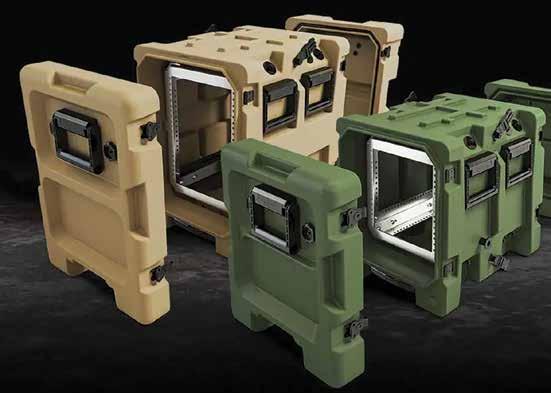
the evolving needs of modern defense applications. The embedded intelligence allows flexible sharing through dispatchable power, which can be configured to control voltage, balance current, or temperature across multiple power supplies. Additionally, Power Blade’s intelligence allows system designers to utilize a dual data bus communication where a system controller or chassis manager can talk to the power supply and inquire about input voltages, output cards, power temperatures, and other information from the power supply, possibly predicting failures.
AirBorn airborn.com
Designed, tested, and manufactured in the United States, these complex cases can be used off-the-shelf or configured as needed for specific equipment. RoboRack cases are being introduced in two half-rack sizes: 5U (available now) and 7U (coming later this spring). New RoboRack cases are manufactured with Gemstar’s proprietary Robomold® manufacturing technology. RoboRack double-walled hard cases are airtight and watertight and built to withstand years of use and abuse.
RoboRack Half-Rack cases are manufactured with GSR™ (LLDPE) high-performance resin, heavy-duty latches, rubberized spring-loaded handles, and recessed hardware. They offer stacking compatibility, fully removable lids that hang on the sides, and have a payload of 20 to 150 lbs.
This military-grade case is designed and tested to meet or exceed MIL-STD 810G and military Long-Life Reusable Case (LLRC) standards. RoboRack cases can be customized to meet customer size, load, and g-rating (g-force) specifications. Edge wheels and an extendable handle are standard for additional flexibility in moving electronics.
GEMSTAR MANUFACTURING gemstarmfg.com
27 COTS Journal | March 2024
March2024
COT’S PICKS
DT Research 6-inch and 8-inch
Rugged Tablets Deliver Scanning and Tag Reading for Asset and Inventory Management
Complete Windows Compact IP65 Tablets with Long-range Scanning to Improve Data Accuracy, Productivity, and Safety
Research, the leading designer and manufacturer of purpose-built computing solutions for vertical markets, announced the company’s DT362DN (6-inch) and DT382DN (8-inch) rugged tablets for ultra-mobile computing in the office, warehouse, and field. The DT362DN and DT382DN handhelds run the Microsoft® Windows® 11 IoT Enterprise operating system for flexible integration with existing applications and systems. The powerful Intel® Core® i3-N300 8-Core processor (up to 3.80 GHz) and 16GB of RAM provide ample workload support. With features and options such as RFID and NFC readers, barcode scanners, GPS, Smartcard/CAC reader, and cameras, these tablets streamline data collection for asset and inventory management and mission-critical projects.
“By focusing on our customers’ exact needs, we
Kontron mini-ITX SBC features extensive scalability and expansion options
12th and 13th Generation Intel Core processors support real-time industrial applications
Display solutions and embedded systems provider Review Display Systems (RDS) has announced

are able to deliver the products they need to be successful. This commitment to continuous improvement based on customer feedback and the latest technology enables DT Research to offer the best value and targeted products for focused needs,” said Daw Tsai, President of DT Research.
The DT362DN and DT382DN have SD card slots for quick access to camera and drone data retrieval, dual-frequency RFID/NFC for reading tags, NIST-compliant bios with antireflective capacitive touch screens, and hot-swappable batteries for ease of use and continuous operation. Built-in WiFi and optional long-range wireless communications keep staff connected to their networks.
Long Range Scanning
With optional long-range barcode scanners, the DT362DN and DT382DN can read 1D and 2D barcodes up to 60 feet away, improving inventory productivity and staff safety. The optional integrated UHF (Ultra High Frequency) RFID reader on the DT382DN and in the trigger grip for the DT362DN
the introduction of a new industrial-specification mini-ITX single-board computer (SBC) from the leading global provider of embedded computing technology, Kontron. The Kontron K3833-Q miniITX provides a wide range of scalability with support for a multitude of Intel processors, including the 12th and 13th generation Core i9, i7, i5, and i3 processors, and the Intel Pentium and Celeron processor series, coupled with extensive expansion options.

Designed and developed for embedded applications requiring 24-hour continuous operation, the K3833-Q mITX features an operating temperature range of 0°C to +60°C, a broad range of functionality, and is highly suitable for the application requirements of industrial automation, machine vision, medical devices, digital signage and many more.
Produced in Ger-
streamlines reading asset tags up to 30 feet away.
Data Capture Options
The 8MP camera with auto focus verifies project status and scans QR codes. The Smart Card/ Common Access Card (CAC) reader gives instant access to protected data based on clearance level and processes other forms of ID. The GNSS module offers concurrent reception of GPS for tracking and location mapping needs.
Military-grade Durability and Reliability
The DT362DN and DT382DN fanless handhelds are IP65-rated for water and dust resistance and MIL-STD810H certified for shock and vibration protection. They are also FCC Class B and RoHS certified.
DT Research dtresearch.com
many, the industrial-specification K3833-Q mITX has the high-performance Intel Q670E chipset. The Q670E chipset offers remote administration and maintenance, enabled by out-of-band management functionality provided by Intel Active Management Technology (Intel AMT). Additional features include SATA, RAID, integrated LAN, Wireless, and many expansion options.
Peter Marchant, embedded division manager at RDS, said, “The new Kontron K3833-Q provides impressive levels of scalability across a broad range of Intel CPUs, together with an extensive expansion capability. Offering an effective cost of ownership, the mini-ITX motherboard can be used across a broad range of embedded industrial applications.”
The single-board computer is equipped with dual Intel Ethernet (1x 1 GbE / 1x 2.5 GbE) supporting Time-Sensitive Networking (TSN) for real-time critical applications, a PCIe x16 Gen 5 (16 lanes) expansion slot, high-performance USB 3.2 Gen2, one M.2 Key-M, and one Key-E slot. Implementing two DIMM sockets for up to 64GB DDR5 memory enables best-in-class system performance.
Kontron kontron.com
COTS Journal | March 2024 28
March2024
COT’S PICKS
Cogniteam Selects RTI Connext® to Enable Seamless Communication within its Cloud Robotics Platform
Connect Meets Market Demands for Massive Scalability to Develop, Deploy, and Manage Robots and Fleets
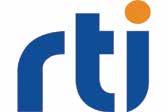
Real-Time Innovations (RTI) announced that Cogniteam, a robotics AI software development company, has selected RTI Connext® to provide commercially supported communications to its unified cloudbased platform for the robotics industry. Cogniteam brings users a unique robotic AI solution in one place, where they can design, develop, and test robots. By leveraging Connect, based on the Data Distribution Service (DDS™) standard, developers can monitor incoming data from robots to the cloud in real-time. Connext enhances productivity as Cogni-
Curtiss-Wright Rugged MPSoC Module
Speeds the Integration of Trusted and Secure Processing Features to Deployed COTS Hardware
The new XMC-529 AMD Ultrascale+ MPSoC XMC module rapidly integrates cybersecurity technologies into deployed VPX systems.
Curtiss-Wright’s Defense Solutions Division has expanded its family of Enhanced TrustedCOTS™ plug-in modules designed to bring trusted and secure processing to rugged deployed VPX-based
team achieved coding translation from ROS to ROS 2 in one month – compared to the market norm of three to six months – saving critical time and money.
When selecting a software framework for its autonomous robotic platforms in land, air, and sea, Cogniteam required a solution tailored to their specific needs that could achieve communication functionality from ROS to ROS 2 and a seamless way to talk between systems. Connext offers both a native DDS and a commercially supported RMW layer for ROS, which allows Cogniteam’s platform to communicate via the cloud in production and remote settings, providing all the functionality of getting data and controlling robots.
“New and exciting tools are emerging in robotics to facilitate the interconnectivity of systems and components at the edge and in the cloud,” said Ari Yakir, Vice President of Research and Discovery at Cogniteam. Connext did exactly what we needed it to—from adding functionality between libraries to retrieving critical data from the edge device—speeding up our production timeline and advancing robotic platform
systems with the introduction of the XMC-529 AMD Ultrascale+™ MPSoC XMC Mezzanine Card. The XMC-529 speeds the integration of advanced system IP into VPX, ATX, and legacy VMEbus systems. The module can also increase a system’s overall computing power by providing FPGA co-processing to the baseboard.
“Our XMC-529 and XMC-528 TrustedCOTS modules reduce the cost and time required to ensure trusted and secure high-performance computing in embedded MOSA-based electronics systems,” said Brian Perry, Senior Vice President and General Manager of Curtiss-Wright Defense Solutions. “The XMC-529, which has already been selected for use in a prime integrator’s program, enhances critical data and technology on deployed systems while eliminating the need to customize the target hardware to support proprietary cybersecurity technologies.”

Curtiss-Wright optimizes system architecture flexibility for deployed solutions
development.”
Cogniteam selected Connext to support a wide range of autonomous robotic platforms and be the first company to enable support for a wide range of autonomous robots in a unified way via the cloud. RTI’s trusted distribution partner in Israel, Matrix, oversaw the integration process of Connext with Cogniteam’s edge device agent and provided on-site technical enablement and support.
“Robotics are enabling efficient autonomy and productivity in nearly every vertical,” said Bob Leigh, Senior Director of Commercial Markets at RTI. “Connect includes an open interface and advanced integration capabilities that slash costs across a system’s life cycle, from initial development and integration through ongoing maintenance and upgrades. We’re proud to have a long-standing relationship with Cogniteam, and we welcome them to our expansive ecosystem of companies choosing Connect as their commercial DDS solution.”
RTI rti.com
and provides a common, advanced, trusted, and secure framework that can be deployed using the XMC-529, the previously introduced XMC-528, or via the on-module FPGA devices hosted on its VPX boards.
Enhanced TrustedCOTS XMC (VITA 42/61) cards eliminate the need for costly and time-consuming customization of the target hardware. The XMC-528/529 modules enable system integrators to add IP to fielded systems quickly without a complete redesign. These cards have also been deployed in high-performance rack-mount servers using Curtiss-Wright rugged carrier solutions. For customers of Curtiss-Wright’s XF07 family of XMC I/O modules, the XMC-529 provides a compelling replacement option.
The compact XMC-529 module is optimized to work with Curtiss-Wright’s Fabric100™ family of extremely high-performance SOSA-aligned 100Gbit processing engines, such as the recently introduced VPX3-1262 single board computer (SBC), which is powered by Intel’s 13th Gen “Raptor Lake” 14-core hybrid architecture processor. The XMC-529 can also be hosted on various system modules, such as Curtiss-Wright’s VME-1910, VPX6-1961, and VPX31260 SBCs.
Curtiss-Wright curtisswright.com
29 COTS Journal | March 2024
COT’S PICKS
General Micro Systems’ Lightweight Smart Rugged Tablet/Display Adds Unmatched Flexibility, Portability and Intelligence to the Battlefield
Designed to go from mounted display to tucked under the arm as a dismounted handheld tablet computer with a powerful ARMbased Qualcomm AI processor and multiple built-in I/O, this fanless, completely sealed X9 Spider system is one of numerous innovations showcased in GMS booth #1537 at West 2024 February 13-15
General Micro Systems(GMS) recently introduced a high-definition (HD) rugged Thunderbolt display that adds the Qualcomm® QRB6165 embedded/AI processor, uniquely enabling the tablet to be mounted on a ship or vehicle, mounted and then dismounted for portable operations or used exclusively as a lightweight handheld self-contained tablet computer.
In October 2023, GMS introduced a lightweight, rugged, and high-definition Thunderbolt display that uniquely extended the bus of the X9 Spider Host Computer’s processor into
the display to enable local I/O and mix-andmatch modular capability. The X9 Spider Rugged Thunderbolt Tablet/Display introduced today offers these same capabilities but adds the mobile phone ARM®-based Qualcomm QRB6165 mobile processor for generative AI, inference tracking, extreme vector graphics, and image processing/enhancement. The device can now serve as a “smart” complete mission computer with ample built-in I/O in a portable tablet that Navy SEALs, Marines, or soldiers can carry for real-time access to highly critical information.
“There’s nothing like this in the market, whether from a defense or pure commercial supplier: it’s a breakthrough first,” said Ben Sharfi, president and chief architect, GMS. “By adding the impressive capabilities of the Qualcomm AI processor, the X9 Spider Rugged Thunderbolt tablet and display becomes a smart, lightweight, flexible tablet like no other on the battlefield. Available in feather-weight carbon fiber, not only can this tablet be mounted on a ship or in a vehicle, connected with Thunderbolt to a separate, distant host computer, but without missing a beat, it can be dismounted and used as a longlife portable wireless tablet, providing the
same information that was available while operating shipboard or in a vehicle.”
With a day-long battery, the tablet meets multiple mission profiles in different vehicles, platforms, and theaters of operation. The tablet/display also runs Android and Linux—another unique capability for maximum application flexibility, long life, and Department of Defense (DoD) software control throughout the life cycle.
Four size options with bright LCDs, resistive touch screens, removable storage, security
The Qualcomm CPU is mobile-focused and has onboard systems explicitly designed for I/O, image tracking and enhancement, video processing, DSP-based audio processing and enhancement, noise cancellation, and first-class security with included TPM. It is intended for use in embedded machine vision battery-powered appliances, with all-day battery life, object recognition, voice recognition, and blazing speed. For example, sailors, Marines o, and SEALs can talk to the tablet— even under extreme stress—and this alleviatesd the use of the touchscreen interface or optional keyboard.
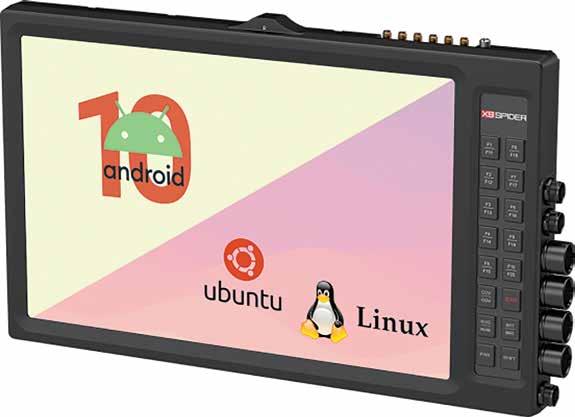
The smart Thunderbolt Tablet/Display is designed to provide the highest level of performance possible in a fully ruggedized, fanless, completely sealed system with an ultra-bright LCD and optional Night Vision Imaging System (NVIS). While available in 10”, 12”, 17”, or 24” diagonal LCD sizes in the thinnest and most rugged display chassis on the market today, the 12” version is ideal for dismounted Navy SEAL/Marines/soldier applications.
“The smart Tablet’s use for the warfighter is game-changing,” Sharfi added. “Cool to the touch, rugged, thin, wireless, and lightweight, never before has such a dual-mode smart tablet/display been available. GMS is the first.” GMS gms4sbc.com
March2024
COTS Journal | March 2024 30


Index
Company Page # Website Annapolis Micro Systems ...................................... 8 ........................................ www.annapmicro.com Behlman Electronics ............................................. IFC/20 ............................................. www.behlman.com Core Systems ........................................................ 7/BC ..................................... www.core-systems.com Great River Technology ......................................... 4 .................................... www.greatrivertech.com Holo Industries ...................................................... 5 ................................................ www.holoind.com Interface Concept ................................................. 14 ................................ www.interfaceconcept.com OTEK ...................................................................... 11/18/19 ............................................. www.otekcorp.com PICO Electronics, Inc ............................................ 13/IBC ................................... www.picoelectronics.com Pixus Technologies ................................................ IBC ............................... www.pixustechnologies.com COTS Journal (ISSN#1526-4653) is published monthly at; 3180 Sitio Sendero, Carlsbad, CA. 92009. Periodicals Class postage paid at San Clemente and additional mailing offices. POSTMASTER: Send address changes to COTS Journal, 3180 Sitio Sendero, Carlsbad, CA. 92009.
COTS ADVERTISERS COTS




























































